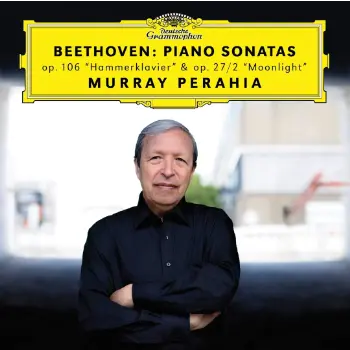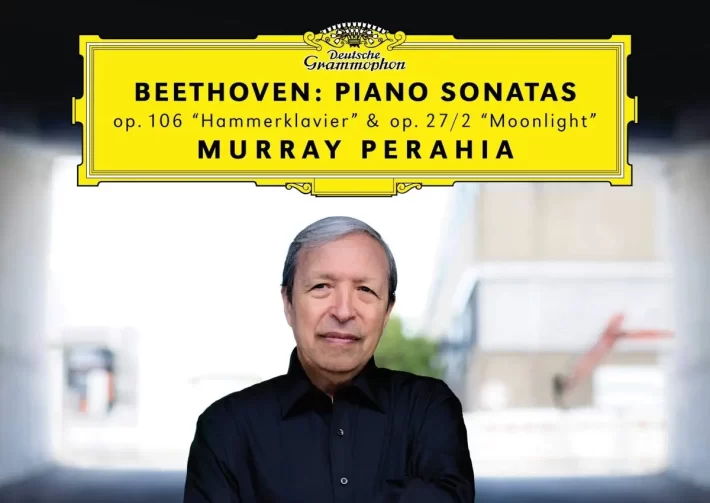How does he do it? With every release the great American pianist Murray Perahia takes familiar works from the core of the piano repertoire and manages to make us listen to them afresh. Both works in this album are a first in Perahia’s discography (I recall a recording of the moonlight few decades ago, but in any case it’s currently unavailable). He recorded many of the 32 over the years, but rarely the late ones.

Every decade, it seems, brings it’s own one or two “classic” Hammerklavier. Last decade it was Schiff, Kovacevich and Guy, with an irresistible performances, and a decade before that there were Brendel with his third, live performance from Vienna’s Musiverien, along with Richard Good’d more intimate survey. And all of these performances over the years are compared, almost automatically, with Schnabel, Solomon and Gilels. This decade brought us some very exciting surveys — Namely Jonathan Biss and Igor Levit.
So how does Perahia’s Hammerklavier stacks-up? To say it plainly — It goes directly to the list of “Classics”. Yes. It’s that good.
The first movement of Op. 106 seems to hit the spot in regards to tempo — 10’09” compared to Schnabel’s hectic 8:54’ and Gilels bombastic 12:32’. But it’s not only tempo. Perahia’s is a down to earth approach, exhilarating yet measured, sophisticated but never studied.
The Sonata, from start to finish, has a sense of urgency, even in the famous slow movement. Here, although not the fastest in the catalogue, it seems moving forward and echoing the loud drama from the previous movements. In the frightfully difficult fugue, Perahia conveys the sense of an artist tries to decide on the right path — Listen to the way he almost seems to improvise the first 2 minutes of the last movement.
With all of the great complexity of this long sonata, in Perahia’s hand it seems much more accessible. It’s not only a monument to Beethoven late style and endless musicology research, it gives pleasure and excitement as well.
The “Sonata Quasi Una Fantasia”, op. 27 no. 2, is mistakingly called “Moonlight” based on Ludwig Rellstab’s famous remark on the looks of the lake Lucern, some 5 years after Beethoven’s death. Edwin Fischer famously correlated the first movement with Don Giovani commendatore death scene. In any case, Perahia’s tempo is again right on the spot — Not hurried nor drags, gives enough space for the harmonic progress to register.
As for the pedal, an intriguing debate is developing in the past few years on the “Sensa sordini” (“Without dampers”) instruction, which Beethoven left at the top of the score. Schiff experimented with the extreme — Never changing the pedal for the whole movement. Brendel changes it a a split second after the bit, giving the elusion of the harmonies overlapping. Perahia takes a more conventional approach, changing the pedal with each new harmony, but never sounding forced or too intrusive. His dynamic range is more wide than some, what gives the first movement another sense of fantasy.
Perahia also follows Beethoven’s instruction “Attacca” (Without a break), and plays the whole sonata without an interruption. The second movement is like a sudden sunshine after the gloomy first, and the third movement starts with an impressive finger work. The only misgiving I have for this movement is the matter-of-fact way with the development section (3:00’ and forward). Take Pires’ performance as an example of a true sense of magical wonderment when the left hand “interrupts” with the second theme.
Perahia change of labels from Sony Classical to DG didn’t change his production methods. He still records in the Berlin Rundfunk, with what sounds like the same instrument. The recording is masterful — Picking up the full range of Perahia’s colors but never sounds clinical or dry.
A new “Classic” Hammerklavier than, and an impressive Opus 27 no.2. Now one can’t wait for some more late Beethoven from Perahia.

Album Details |
|
|---|---|
| Album name | Beethoven – Piano Sonatas No. 14 (“Moonlight”), No. 29 (“Hammerklavier”) |
| Label | Deutsche Grammophon |
| Catalogue No. | CD 0289 479 8353 8 |
| Artists | Murray Perahia, piano |

















